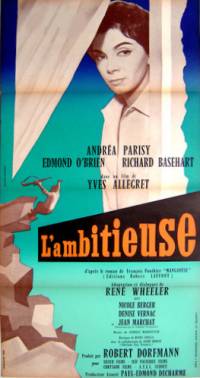Development
The movie was the last of three co-productions Australians Lee Robinson and Chips Rafferty did with French companies in the late 1950s, after Walk into Paradise and The Stowaway. The films were shot in English and French versions with a combined Australian and French crew. While Walk into Paradise was set in Papua New Guinea, then an Australian territory, and starred an Australian, Chips Rafferty, both The Stowaway and The Restless and the Damned were essentially French stories, albeit with international casts. [1] [7]
Rafferty and Robinson contributed £40,000 of the film's budget, coming from hire of studio facilities to two films shot in Tahiti and their involvement in several episodes of the US documentary series, High Adventure. [8]
Robinson said they did not have the funds to be a full partner in the film but they contributed 30% of the costs while the French partners contributed 70%. "It's a major international film, with American stars in it, and French stars," said Robinson. "Andrea Parisy was a French star and the French ended up having to carry the whole of the load, which they could afford to do." [1]
Robinson said "Dorfmann is one of the most brilliant producers in Europe. And if we could have maintained some working relationship with Dorfmann, we might have got somewhere. He's a very talented producer." [1]
Edmond O'Brien later said his net from the film "will obviously exceed the $150,000 or $200,000 most actors can hope to realize from a Hollywood salary." Producer Dorfman claimed "The revenue a European production can get without a Hollywood star is, at best, limited. On the other hand many actors such as Mr O'Brien and Robert Ryan are top attractions in the European and Oriental countries where we obtain our major income." Dorfman said they signed O'Brien on the strength of his performance in The Girl Can't Help It adding "throughout Europe it was considered a comedy of importance and established O'Brien as a major attraction there - much more, for instance than his Academy Award role in The Barefoot Contessa." [9]
O'Brien called his role "half Wallace Beery half Humphrey Bogart". [10] [11]
Production
The film started shooting in September 1958 in Tahiti and Tuamotu Island. [12]
Originally Lee Robinson was to direct the English-language version, which had happened on the first two films, but after a few days Yves Allégret directed both. [13]
Filming took three months. O'Brien said "There were no studios so we had to shoot our interiors where we could. One place had a tin roof, and you can imagine how that was, combined with our lights from the color camera.” He described the weather as murder. “Hot? That doesn’t begin to describe it. I sweated right through a mattress every night." [14]
In February 1959 Variety reported Basehart had finished filming interior scenes in Paris. [15] In April 1959 Variety called the described the film as "about a fight over mines in Tahiti and may loom an actioner with playoff chances. It has names in Richard Basehart and Edmond O’Brien." [16]
O'Brien arrived in Paris in July 1960 to dub the film into English. [17]
